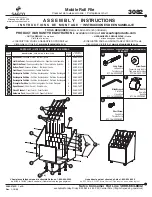
RP0193-2001
18
NACE International
(c) Operating currents
(d) Locations of test facilities
(e) Key monitoring locations
(f)
Equipment manuals
(g) Tank fluid level
10.5.2
All collected data should be recorded and
documented for future reference.
10.6
Error Sources: Consideration must be given to
sources of error when potential readings are made on
aboveground storage tank (AST) bottoms. Some of these
error sources include:
10.6.1
Measurement Circuit IR Drop: The soil or fill
under a tank bottom can be dry and have a high
electrolyte resistance. Under these conditions, an IR
drop error occurs in the measuring circuit if a low-
input impedance meter is used.
This error can be
minimized using a meter with an input impedance
greater than 10
6
ohms.
10.6.2
Tank Bottom Flexing: When product level is
low, the tank bottom can shift upward, affecting the
measurement circuit and changing the area of the
tank bottom being monitored.
This may result in
misleading readings. This error can be minimized by
ensuring that there is sufficient product level in the
tank during measurements.
10.6.3
Measurements
Made
from
Grade
Wall
(single-bottom tanks): Potential measurements made
from grade are strongly influenced by the potentials
at the perimeter of the tank bottom or outside the
ringwall (if present).
To measure the potentials
correctly in the center of the tank bottom, it is
necessary to use either a stationary reference
electrode, or to have an access tube located under
the tank bottom.
________________________________________________________________________
Section 11: Operation and Maintenance of Cathodic Protection Systems
11.1
This
section
recommends
procedures
and
practices for maintaining the effective and efficient
operation of cathodic protection systems for on-grade
carbon steel storage tank bottoms.
11.2
Monitoring Cathodic Protection Systems
11.2.1
The protection systems shall be monitored
to ensure adequate cathodic protection of the tank
bottoms in accordance with the criteria set forth in
Section 4.
11.2.2
Annual surveys should be conducted to
verify that the cathodic protection system is meeting
the protection criteria. Making more frequent surveys
of the system may be desirable in critically corrosive
environments or where highly variable conditions are
present.
The accuracy of stationary reference
electrodes should be evaluated during these surveys.
The effectiveness of isolating fittings and continuity
bonds should also be evaluated during the periodic
surveys.
11.2.3
All sources of impressed current should be
checked at bimonthly intervals to ensure effective
operation of the system. Current and voltage outputs
consistent with previous readings or a satisfactory
polarized potential measured at the protected tank
bottom surface may each be considered evidence of
proper functioning.
11.2.4
Potential
testing
should
consist
of
a
minimum of four equally spaced tests on the external
circumference and at least one test at the center of
the bottom on tanks of 18-m (60-ft) diameter or less.
On tanks greater than 18 m (60 ft) in diameter, eight
equally spaced tests on the external circumference
and at least one test at the center of the tank bottom
should be the minimum testing requirement.
11.2.4.1
Experience has indicated that on
large tanks, potential measurements obtained at
the perimeter of the tank may not reflect the
actual conditions of the entire tank bottom.
11.2.4.2
Potential
measurements
may
be
affected by liquid-level changes inside the tank.
11.2.4.3
The
cathodic
protection
system
should be monitored for the existence of any
stray
current
interference
from
adjacent
structures or protection systems.
11.2.5
All cathodic protection systems should be
inspected
as
part
of
a
predictive/preventive
maintenance program to minimize in-service failure.
Inspections should include a check for electrical
shorts, ground connections, meter accuracy, rectifier
efficiency,
and
circuit
resistance.
Scheduled
maintenance should include removing debris at the
rectifier openings required for cooling and checking to
ensure that all connections are secure and unaffected
by corrosion. Maintenance should include inspection
of junction boxes, test stations, and other equipment.
11.3
Test
equipment
used
for
obtaining
cathodic
protection
data
should be checked periodically for
accuracy and maintained in good operating condition.
11.4
Corrective action shall be taken if surveys and
inspections indicate that the cathodic protection system is
Содержание CP 1
Страница 1: ...CP 1 Cathodic Protection Tester Course Manual February 2005 NACE International 2000 ...
Страница 265: ......
Страница 266: ......
Страница 267: ......
Страница 268: ......
Страница 301: ...RP0169 2002 32 NACE International ISBN 1 57590 035 1 ...
Страница 535: ...TM0101 2001 24 NACE International ISBN 1 57590 137 4 ...
















































